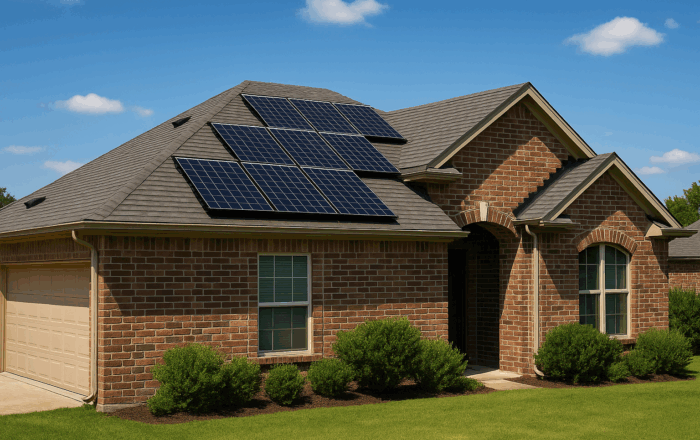Home Improvement Living in Texas
How Many Solar Panels Do You Need in Texas?
4 minute readHow to calculate the number of solar panels you need to power your Texas home
Home > BKV Energy Blog > All Posts > High-Efficiency Furnaces: Most Energy-Efficient Furnaces for Your Home
4 minute read • Last update July 2025

The best energy efficient furnaces are those with the highest AFUE rating (Annual Fuel Utilization Efficiency), or how effectively they convert energy into warm air to keep your home comfortable during the colder parts of the year. The best furnaces will have an AFUE rating of 98.5%.
Aside from a high AFUE rating, reliability and durability should be your top priorities. While most manufacturers offer high-efficiency options, not all are equal in quality. So, buying each component of your home heating and cooling system from a reputable brand is recommended to ensure long-term performance, minimal maintenance, and peace of mind. You may also want to consider looking for models with additional ratings and technology features, such as:
The most energy-efficient furnaces utilize advanced technologies and design features that maximize heat output while minimizing energy use. They are classified based on their AFUE rating, which measures the percentage of fuel that’s converted into usable heat. Furnaces with higher AFUE ratings are considered more efficient.
AFUE stands for Annual Fuel Utilization Efficiency. AFUE ratings are expressed as a percentage, indicating the portion of fuel utilized for heating purposes, with the remainder being lost as waste through exhaust gases. For example, a gas furnace with an AFUE rating of 95% converts 95% of the fuel it consumes. So, the best energy-efficient furnace for your home will typically be among those with the highest percentage rating.
Aside from energy efficiency, AFUE plays a significant role in determining how much homeowners save. Higher ratings generally result in lower energy bills since they waste less fuel during operation. Additionally, furnaces that meet established efficiency standards may qualify for incentives like the energy-efficient furnace tax credit or the energy-efficient home improvement credit.
Increased efficiency models are widely available using both gas and electric fuel sources. However, there are a few notable differences regarding optimum efficiency, operating costs, and environmental impact.
An energy-efficient gas furnace typically boasts higher efficiency ratings than an electric model and is likely to be more cost-effective to operate, especially in regions with lower natural gas prices. However, the flip side is that, at least in theory, gas models produce on-site carbon emissions, whereas their electric counterparts do not. However, it’s worth noting that the environmental impact of even the most energy-efficient electric furnace will depend on the source of electricity generation in your area.
It’s essential to weigh the advantages and disadvantages of high-efficiency gas furnaces carefully before making changes to your existing heating and cooling system. Here’s a breakdown of the pros and cons to help you make an informed decision.
Aside from the energy-efficiency factors and rating systems we’ve already mentioned, there are some additional features that could make a considerable difference in terms of convenience and operation. Let’s take a quick look at the primary contenders.
Variable speed motors adjust their speed based on heating demands, providing more precise temperature control, improved energy efficiency, and quieter operation.
Modulating valves allow furnaces to adjust the amount of fuel they burn in response to heating requirements, resulting in consistent temperatures, reduced energy consumption, and enhanced comfort.
Furnaces equipped with electronic controls offer advanced programming options, diagnostic capabilities, and system monitoring, ensuring efficient operation and easier troubleshooting.
The secondary heat exchanger maximizes the amount of heat transferred from the combustion process into the air circulated throughout your home, increasing efficiency and reducing fuel consumption.
Furnaces with advanced filtration systems (or compatibility with high-efficiency air filters) improve indoor air quality and protect your HVAC system from dirt and debris buildup.
Furnaces with zoning capabilities allow for customized heating zones within your home, optimizing comfort and energy efficiency by directing heat only where it’s needed.
Unsure whether it’s time to get a new furnace? Here’s a list of telltale signs indicating it may be time to switch your existing unit for one with better efficiency:
As you can see, investing in one of the most energy-efficient furnaces on the market can help lower utility bills and reduce your carbon footprint.
At BKVE, we understand the importance of both affordability and sustainability. That’s why we offer a range of energy solutions tailored to meet your needs. Check out our straightforward energy plans and start saving today!
Graham Lumley, Digital Marketing Manager at BKV Energy, leads digital and traditional marketing strategies, focusing on educating Texans about the state's deregulated energy market. With over 8 years of marketing experience, he creates content to help consumers understand and save on their energy bills, bringing a fresh and dynamic approach to the industry.

Home Improvement Living in Texas
How to calculate the number of solar panels you need to power your Texas home

Gardening in Texas presents unique challenges. Long, hot summers and frequent droughts mean that traditional landscaping often requires significant water
Get $50 off your electric bill!
Use code BKVEJOINUS50
Enter your zip code to shop BKV Energy's affordable, fixed-rate Texas electricity plans. Use the promo code for $50 off your electric bill.